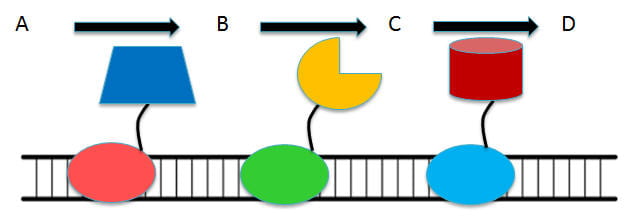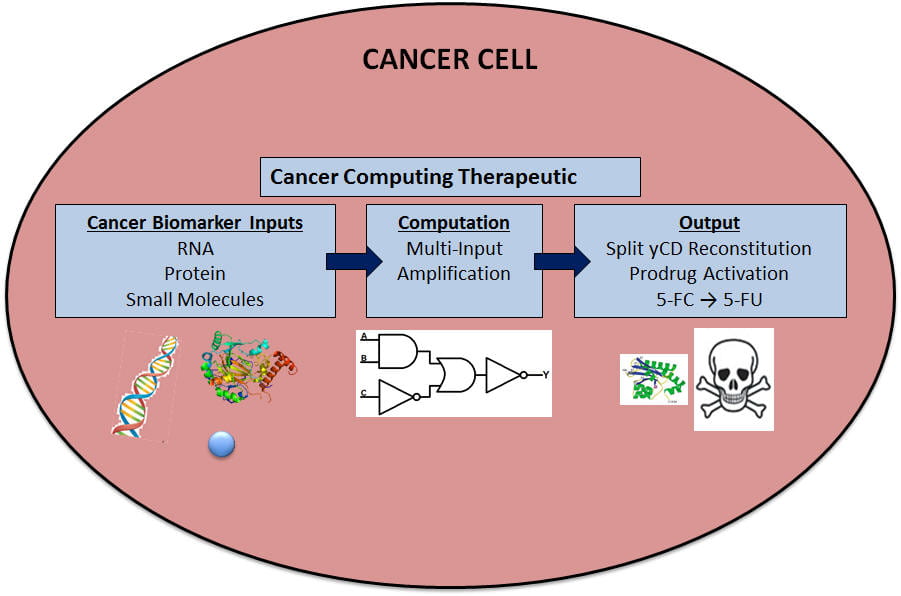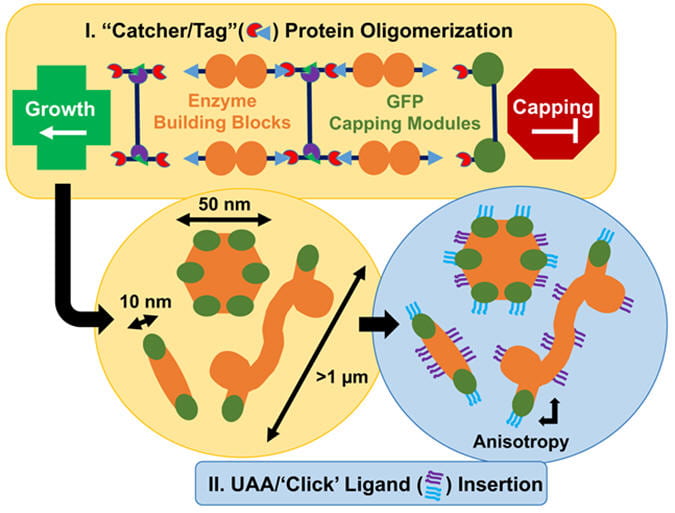
A. Dynamic modulation of cellular phenotypes
In nature, dynamic interactions between proteins play a crucial role in defining many cellular functions such as metabolism, cell signaling, transcription regulation, apoptosis, cellular targeting, and protein degradation. By controlling the spatial and temporal organization of these supramolecular complexes, cellular functions can be modulated in a highly dynamic manner for optimum efficiency. Understanding how these proteins interact holds the key to deciphering their roles in native cellular function and in creating new cellular functions for synthetic biology applications. By adding logical components into our designs, our goal is to create new synthetic biology frameworks that are dynamic in nature in order to adapt to the constantly changing cellular environments for dynamic modulation of phenotypes on demand.
-
Project 1. Synthetic Control of Metabolism by Dynamic Metabolons (NSF)
The ability to optimize pathway flux is one of the most important factors toward maximizing product titers. The traditional approaches largely focused on the overexpression of rate-limiting enzymes, competing pathway deletion, and resource management. However, most of these approaches are static in nature and do not provide dynamic regulation of pathway fluxes based on substrate,…Continue…
-
Project 2. Repurposing the CRISPR-Cas9 system for dynamic control of cellular metabolism (NSF) – with Prof. Papoutsakis
Cellular metabolism is capable of highly specific and efficient chemical synthesis at mild temperatures and pressures far beyond the capability of most synthetic chemical routes. Although pathway engineering can be used to further improve the range of compounds that could be synthesized, achieving commercially viable productivity remains challenging. An emerging strategy to combat these issues…Continue…
-
Project 3. Redirecting cellular metabolism via synthetic toehold-gated dCas9 regulators (NSF)
Cellular metabolism is capable of highly specific and efficient chemical synthesis at mild temperatures and pressures far beyond the capability of most synthetic chemical routes. Engineering specific pathways can be used to further improve the range of compounds that can be synthesized but it is a major challenge to achieve commercially viable productivity. To maximize…Continue…
-
Project 4. Dynamic modulation of cellular functions by controlled protein degradation (NSF)
Aberrant protein levels and activities contribute to numerous diseases, including cancers, cardiovascular disease, diabetes, and neurodegenerative diseases. No current therapy dynamically degrades excess protein(s) to treat diseases. The ability to tightly coordinate the levels of cellular proteins is critical for normal healthy cells to maintain homeostasis. We are developing new strategies that elicit dynamic and…Continue…

B. Nano protein scaffolds for biocatalysis, biosensing, and therapeutics
Proteins are the most versatile among the various biological building blocks and efforts in protein engineering have resulted in many industrial and biomedical applications. Our approach is to exploit the modular nature of different protein domains in order to design synthetic protein scaffolds that can perform completely new biological functions. We are developing new strategies in designing exchangeable protein domains for predicative engineering applications in (1) biocatalysis, (2) biosensing, and (3) disease therapeutics.
-
Project 1. Synthetic multilayer targeting DNA devices for detection of specific cancer indicators and programmed assembly of split yCD for prodrug activation (NSF)
One of the most pressing needs in cancer treatment is to distinguish and treat cancer vs healthy cells. Active targeting of surface markers alone is inadequate and must be merged with additional layers of intracellular signals to provide a higher level of specificity. Advances in synthetic biology have enabled the engineering of new cellular sensors,…Continue…
-
Project 2. Design of Multi-Functional SplitCore HBV Capsids for Precisely Controlled Multi-siRNA Delivery in Cancer Therapeutics (NSF) – with Prof. Sullivan
Virus-like particles are perfectly monodisperse self-assemblies of protein-only subunits that are ideal for therapeutic delivery applications because both capsid surfaces and interiors can be stoichiometrically decorated with moieties for cell targeting and siRNA capture/release. We will exploit the newly discovered SplitCore strategy for the formation of HBV capsids using fragment complementation of the separately expressed…Continue…
-
Project 3. Design of RNA-triggered Disassembly Mechanisms in Multi-responsive Polymer Nanocapsules for Personalized Physiological Profiling and Tailored Therapeutics (NSF)
This research addresses the National Academy of Engineering’s Grand Challenge to engineer better medicines by developing new approaches that will ultimately allow rapid assessment of the genetic profiles in patients and the release of personalized drug cocktails. Our approach is to incorporate DNA “strand displacement” biosensing designs within polymer nanocarriers such that the DNA interface controls…Continue…
-
Project 4. Engineering protein nanostructures to illuminate protein delivery and cellular processing (NSF) – with Prof. Sullivan
This project will develop new approaches to create nanoparticles using therapeutic proteins as building blocks. The protein building blocks will be designed so that they can assemble together spontaneously to form flexible, elongated nanoparticles; additionally, the protein building blocks will be designed to incorporate clusters of ‘targeting’ molecules that will bind strongly and specifically to…Continue…
-
Project 5. Advanced Biomanufacturing of Functional Bionanoparticles for Bioimaging (NSF)
Research on nanomaterials in the past decades has undergone explosive growth. Although recent progress in nanomanufacturing technologies led to successfully large-scale manufacturing of a range of inorganic and organic nanostructured materials, the extension of those manufacturing processes to the production of advanced functional bio-nanoparticles (bio-NPs) is currently an unmet challenge. This is mainly due to…Continue…








